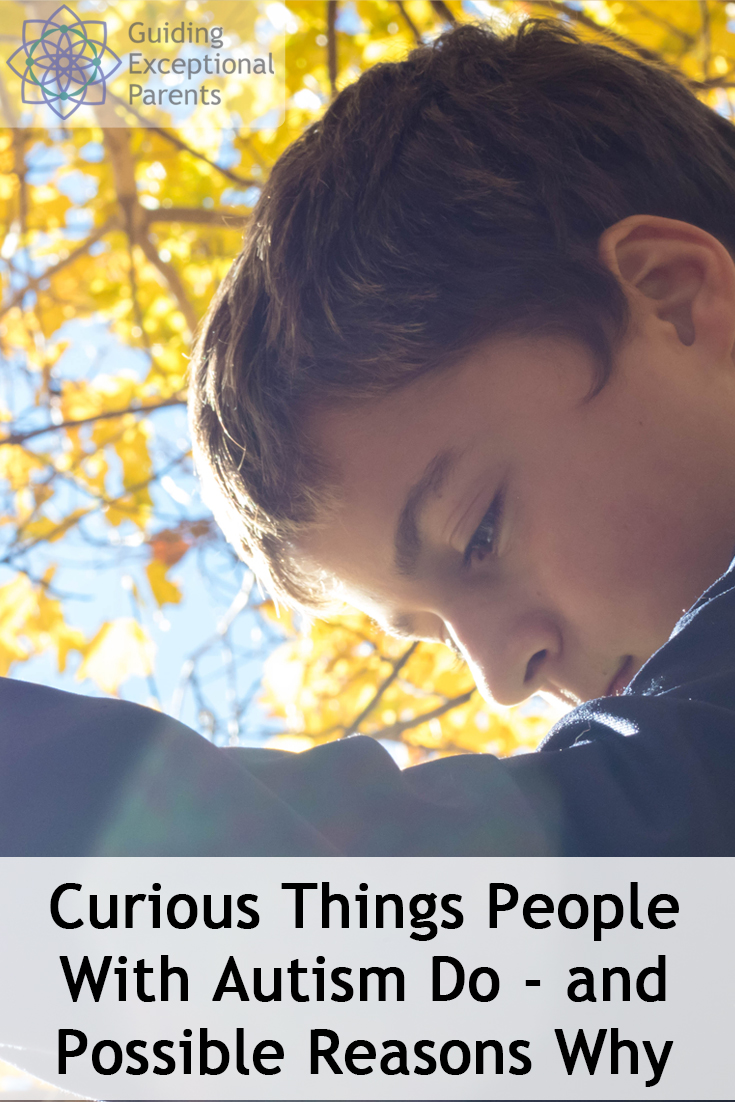This post was originally published on Parenting ADHD & Autism on October 12th, 2016.
Kids with autism have a unique way of thinking about the world that can be both fascinating and baffling. Often their intentions are misunderstood because they behave in ways that are unexpected.
This chart can help demystify some of those behaviors.
As you read this list, remember that not all people with autism have all the issues listed on the chart. Every person has their own unique constellation of gifts and challenges. The issues below are issues that come up for many (but not all) people with autism.
| Teacher’s or Peer’s Impression |
Possible Reasons for Behavior |
| Uncaring and/or rude |
- Has difficulty understanding social cues (especially nonverbal cues like posture, gesture, facial expressions, and tone of voice).
- Doesn’t pick up on social expectations or norms of classroom behavior.
- Isn’t aware that his/her classroom behavior disturbs classmates (e.g. noises, movements, sprawl of books).
- Doesn’t notice (and thus doesn’t respond to) social invitations.
- Has difficulty understanding that other people have different experiences and opinions.
- Doesn’t realize that everyone doesn’t know what he or she knows.
- Finds eye contact distracting – cannot listen while maintaining eye contact.
- May be impulsive (as part of co-occurring ADHD diagnosis).
- Isn’t always aware of how others are feeling, until their response becomes unmistakable.
- Has sensory challenges (over- and/or under-sensitivity) that make it hard to attend to other people.
- Wants to be part of the group, doesn’t understand how to participate appropriately, so does it in unexpected ways.
|
| Awkward in social conversations |
- Has difficulty initiating social interactions.
- Doesn’t pick up on norms of social interaction.
- Isn’t always aware of how others are feeling, until their response becomes unmistakable.
- Talks too much on topic of interest because of inability to read the signs of listener’s boredom or irritation.
- Misunderstands what other person said because of subtle language issues. Examples include:
- Very literal interpretations, often concrete in nature;
- Difficulty processing complex sentences;
- Difficulties understanding pronouns;
- Difficulties with words that have more than one meaning;
- Surprising vocabulary omissions;
- Trouble with verb tenses, plural markers, etc.;
- Trouble with words indicating sequence (first, next, then, etc.)
- etc.
- Sticks to familiar topics because subtle word finding issues make unfamiliar topics more challenging.
- Conversations are at a faster pace than the student can process. Especially true when more than one other person is involved. Students respond either by withdrawing, or by trying to control the interaction.
- Sticks to familiar topics when slow processing speed makes it hard to shift quickly in response to others’ comments.
- Has difficulty quickly understanding and absorbing what someone said.
- Unsure how to repair communication breakdowns.
|
| Off-topic classroom comments |
- Has difficulty determining the main topic of discussion.
- Is deeply curious about details that may not matter to others, while missing the big picture.
- Wants to be part of the group, but doesn’t realize it is important to stay on topic.
|
| Introverted/anti-social |
- People with autism are introverted, extroverted, and everything in between. Personality type varies just as much as it does in the non-autistic population.
- Is discouraged and disengaged as a result of repeated social failures. This looks like introversion.
- Has difficulty quickly understanding what someone said. This can look like a lack of desire to interact.
|
| Disorganized, late, lazy, lacks follow-through |
- Has poor time awareness.
- Has difficulty prioritizing.
- Has difficulty breaking big tasks down into smaller, more manageable chunks.
- Poor fine motor skills make written work look sloppy.
- Has difficulty holding spoken directions in mind and forgets what to do.
|
| Doesn’t feel emotions |
- Feels emotions as strongly (and sometimes more strongly) than non-autistic people, but outward expression appears flat. An autistic person may be quite unaware of how his or her own body language is perceived.
- Has a default “logical” response to situations that others might find overwhelming.
- Doesn’t understand the emotional reasons for a behavior.
- Doesn’t understand why people would feel as they do.
- Has sensory challenges that lead to an under-reaction to environmental sensations (sounds, lights, smells, etc.).
|
| Over-reacts emotionally |
- Has an emotional response to a trigger that a non-autistic person may not understand or notice
- Misunderstands confusing or complicated social situations – can sometimes lead to perception of being bullied or teased
- Has sensory challenges that lead to an over-reaction to sensory inputs (sounds, lights, etc.)
- Isn’t always aware of his or her own feelings, until they become overwhelming.
- Has difficulty letting go of a thought.
|
| Stubborn |
- Has difficulty coming up with a new strategy when needed.
- Has difficulty modifying or delaying a task when needed.
- Has difficulty letting go of a thought.
- Has difficulty transitioning from one activity or expectation to another.
- Has difficulty understanding that other people see things differently.
- Has subtle language comprehension issues that lead to misunderstanding.
- Cannot do what you are asking, but doesn’t know how to tell you that.
|
| Lacks common sense |
- Has difficulty making connections between events that others see as related.
- Doesn’t recognize the similarities between situations, so doesn’t learn from past mistakes.
|
| Behaves oddly |
- Needs to move in certain ways to maintain self-regulation (e.g., fidgeting, or pacing, tics, among others)
- Isn’t aware of where his or her body is in space, so bumps into things and people, or stands too close or too far away.
|
| Excels at math, engineering & computers (stereotype) |
- People on the autism spectrum can be brilliant, cognitively challenged, and anything in between. Intelligence varies just as much as it does in the non-autistic population.
- Preferences vary just as much as in the non-autistic population.
- People with autism are usually passionate about their interests and driven to explore those interests deeply.
|
| Not interested in sports (stereotype) |
- Interest in sports varies as much as it does in the non-autistic population.
- Plenty of people on the autism spectrum are excellent at sports, but some may have challenges with motor coordination.
- Team sports that require quickly coordinating with others can be very difficult.
|
Please note that no one student will struggle with all the challenges listed above, but all those with autism will struggle with some of these issues.
Want a copy to share? Download a printable PDF. .
Special thanks to Sue Keisler for her input, encouragement, and insight. She was instrumental in helping me create this, and made important contributions. Monica Adler Werner also made meaningful improvements.
Do you need help with your child? Sarah Wayland can help you figure out how to support your child via classes, Special Needs Care Navigation services, Parent Coaching, or as your certified Relationship Development Intervention (RDI) consultant.
Share this post on Pinterest!




Thanks for posting stuff like this I have two sons with autism and people don’t understand them well . Lots of love to the writer for inclusive writing skills .